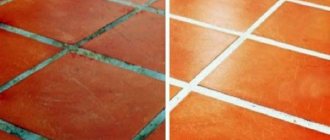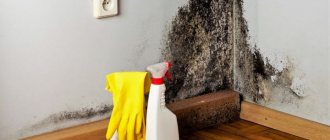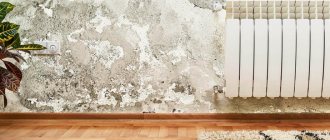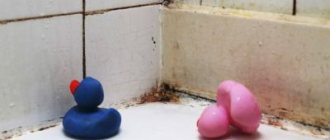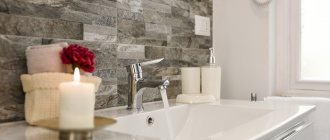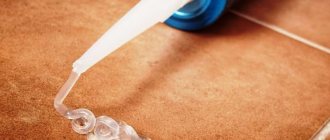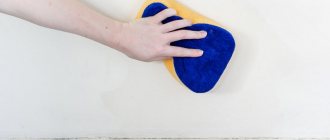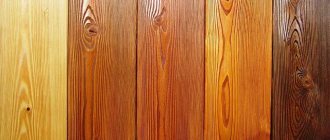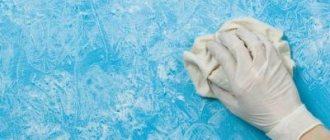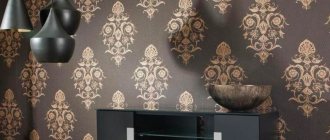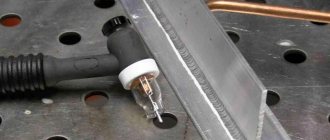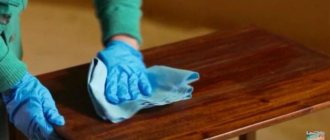Just a couple of centuries ago, mold in a room was perceived as a warning that it was necessary to burn down this very home. It’s good that in our time we don’t have to resort to such radical measures. And although the appearance of such a fungus in the house is very unpleasant, it is quite possible to remove it. In this article you will learn how to get rid of black mold: we will take a closer look at some of the most effective ways to combat the fungus.
How to get rid of black mold - tips
Why is mold dangerous?
Many of us, having discovered mold, put off removing it until later, when we have time, money, etc. And this can be fraught with danger to their health. As mold develops in your home, many diseases can also develop, such as:
- Asthma and allergies
- Choking attacks and constantly stuffy nose
- Eczema and dermatitis
- Bronchitis and other respiratory diseases
Therefore, if you find a fungus in your home, start fighting without delay, it will cost more.
Interesting fact: A special and very expensive delicacy is blue sausage, which is made in Italy. The sausage is kept in the basement for about a month, after which it is covered with light green mold and sent for special processing, and after three months it can be enjoyed.
How to remove mold smell?
Often, after removing mold from an apartment and subsequent ventilation, the smell of rot still does not leave the room. You can fight it with products that absorb odors. So, you can pour baking soda on the place where the fungus used to be, and after a few hours remove it with a vacuum cleaner: soda perfectly absorbs odors, so after this procedure the smell will either disappear or become much weaker.
You can use charcoal as an odor absorber: briquettes are simply placed around a room with an unpleasant odor, and after a while not a trace of it will remain.
Ventilation
Ventilation must be adjusted. To dry the air, just install an air conditioner. When cooking food, you need to turn on the hood.
Thermal insulation quality
The external and internal parts of the walls of the apartment should be insulated. Be sure to bring the heating system into working condition or completely replace it.
Cracks
Be sure to monitor the serviceability of plumbing fixtures. Through the smallest cracks, moisture can penetrate under the floor, increasing the overall humidity in the room.
Poor sealing of the roof and interpanel joints
Sealing the roof and interpanel joints can reduce exposure to moisture and prevent mold. The procedure should only be carried out by specialists. They are the ones who know the special technology in which the work is carried out efficiently.
Help from specialists
How to get rid of fungus on the wall in an apartment if all proven methods do not bring the desired effect? This is possible if walls infected with harmful fungus have porous surfaces or cracks. How to understand that you need help from competent specialists? The following factors may indicate this:
- The total area of the affected space exceeds 3 square meters. With such an extensive mold infestation, it is quite difficult to deal with them on your own.
- If mold has entered the ventilation system or air conditioner.
- Even with regular cleaning of small lesions, they grow at a fairly high rate.
- Molds appear as a result of extensive water or sewage flooding.
Experienced specialists have tools that allow sanitization even in the most difficult to reach places. These technologies can influence not only the external manifestations of the fungus, but also directly the mycelium.
How to remove mold from walls in an apartment: list of popular fungicides
Although today the construction chemicals market is represented by a wide variety of drugs that can effectively combat the formation of fungus, when choosing the most suitable antiseptic for your case, you need to take into account not only the location of the work, but also the type of spores that will have to be dealt with (which may require consultation with specialists) . Whereas the following products can be identified as universal components for combating mold.
| Fungicide type | Characteristics | Areas of use |
| AtlasMykos | Concentrated mold, lichen and moss remover | Used in rooms with high humidity |
| IzohanGrzybostop | Means for combating fungal and mold spores | Used for treating concrete and plastered surfaces |
| Spectrum | Fungicide for removing fungus in plaster and wood | Suitable for use both indoors and outdoors |
| Snezka Impregnation | Solution for removing algae, lichen, moss, mold | Suitable for processing building plasters and masonry |
| Titan Fungicide | A preventative agent that can remove mold and mildew spores without removing finishing materials | Used in rooms with high humidity to prevent the spread of fungus and mold on plastered, putty, painted surfaces |
| PS 50 | Composition for getting rid of algae from concrete and plastered surfaces | For processing drywall, dry plaster, wood. |
| Anti fungus ABEDIS | It is a safe remedy for combating organic deposits of fungus, mold, moss, and algae. | Used in basements, roofs covered with roofing tiles and eternite, concrete paths, ceramic and stone cladding. |
In addition, to solve the problems presented, paint and varnish and building materials with antiseptic components are being actively introduced today, which minimizes the risk of mold developing later.
Cleaning contaminated walls
Without destroying the wall finishing, the fungus can be removed at the initial stage of its development, when there are less than 10 scattered spots up to 1 cm in size on the surface. These are individual spores that have sprouted. The roots did not pierce the plaster with their roots, and did not unite into a mycelium. Any store-bought antifungal agent for walls, a solution of chlorine, vinegar and soda, is suitable for treatment.
At the initial stage of damage, mold is rarely detected. Usually there are many spots, they are larger than 2 cm and are located in a whole colony. The roots have penetrated the entire mass of plaster and it must be removed, taking safety measures.
- Wear goggles, a respirator, and rubber gloves.
- Clothes must have long sleeves. Fungal spores are small and can penetrate the skin, causing itching and irritation.
- If the walls are covered with wallpaper, remove them.
- Before removing the plaster, wet the wall. There will be less dust when removing the putty. It’s good to spray it with bleach diluted in half with water a day before and a solution of 9% vinegar. The growth of mushrooms will slow down, some will die, and the spores will be several times smaller.
- The wall is stripped down to masonry or clean concrete. Remove the remaining solution with a wire brush.
If the mycelium has not grown all the way through, there is no need to clean it further. This happens if several small areas of mold stains have not united into one, the fungus has settled relatively recently.
After treatment with fungicides, the wall is plastered and puttied. It is necessary to use materials with antifungal agents. They are more expensive than conventional building mixtures, but will not allow the fungus to settle again. Sold ready-made, packaged in plastic buckets. If the cleaning was not deep, you can get by with a deep penetration antibacterial primer. This product must be added when finishing wooden walls.
Each layer of plaster and putty must dry before the next one is applied. Before wallpapering and painting, you need to cover the entire area with an antifungal primer, repeat it a day later, and only after complete drying - after 36 hours, you can apply paint and glue the wallpaper.
Appeal to professionals
Turning to professionals is an expensive procedure, but it will be 100% effective and will rid your home of the harmful effects of pathogenic microorganisms. This is a whole process that requires preparation. It is carried out according to the algorithm:
- identifying the cause;
- restriction of all furniture and structures from contact with other things;
- ensuring optimal climatic conditions for work;
- complete destruction of mechanical fungus;
- chemical treatment;
- drying and restoration measures, if required;
- coating with antiseptic and varnish.
Of course, the scope of work varies depending on the conditions (outdoors or indoors, the size of the surface being treated), and the type of formation.
Methods for removing fungus in a private home
Even in a house with expensive renovations and excellent furniture, fungus can settle on the walls. There are constantly spores in the air, which develop rapidly under the influence of high humidity.
Fungus in the house not only spoils the interior and affects comfort, it is dangerous to human health, as it causes asthma, allergies and other dangerous diseases.
- Eliminate the preconditions for the appearance of fungal mold. Reproduction is favored by a humid and insufficiently warm environment. Therefore, constantly ventilate your home. Keep the curtains open during the day to allow enough sunlight into the rooms.
- Do not block the ventilation. Keep toilet and bathroom vents open. Be sure to install fans in these rooms. It is not uncommon for mold to be found inside old pipes, so replace your plumbing if possible.
- Leave free space between walls and furniture. As a result, air will be able to circulate normally. Buy a special device that controls the humidity level in the house. This will help prevent the fungus from reappearing.
- Clean the affected areas. To destroy the fungus, thoroughly clean the affected areas on the walls. Baking soda and vinegar will make the task easier. Sprinkle baking soda on the infected areas and sprinkle table vinegar on top. You may have to remove a layer of putty if the spores have penetrated too deeply. After the procedure, treat the surface with high temperature using a hair dryer or a large lamp.
- Treat the walls with a mixture of water and copper sulfate in equal proportions. This treatment will help get rid of fungal mold. If you don’t have copper sulfate by hand, use an antiseptic. Special preparations are sold in hardware stores. Then apply the final finish to the walls.
Don't forget to carry out preventive maintenance regularly. Once a month, wipe surfaces with a soda solution or detergent with an antifungal effect. Three tablespoons of baking soda per liter of water is enough.
The tile was damaged
The most difficult part to deal with is mold on tiled walls. I don't want to dismantle the tiles. It is necessary to treat the seams using strong agents.
- Clean all blackened seams between tiles.
- Soak the solution remaining in the depths with strong commercial products or pure Whiteness.
- Repeat every other day 3 – 5 times. The larger the affected area, the longer it is necessary to use antifungal agents to treat the walls.
- When the blackness disappears from the seams, they need to be dried. Then, after treating with an antifungal primer for walls, sand the seams.
After rubbing the seams, you need to wash the tiles by adding vinegar or essential oils to the water. In the future, wash it once a month with laundry soap or rub it with yourself and spray the vinegar solution. Soap and grease stains will be washed away along with bacteria.
The bathrooms do not have windows. It is necessary to install forced ventilation in them, open the door at night so that the room is better ventilated.
In the kitchen, the hood cannot cope with the large amount of steam released during cooking and the operation of kitchen equipment. It is necessary to install hoods with fans and open windows for ventilation every day.
Contacting cleaning companies
If you couldn’t overcome the problem on your own and the black “guest” visits the premises again, you should turn to professionals.
At the same time, the minimum treatment area for which specialists will visit will be 5 m2; the price for applying the chemical composition starts from 350 rubles. per m2.
Getting rid of mold with the help of specialists costs an average of 3 thousand. rub.
All available innovative technologies will be used. Namely – diagnostics, surface cleaning, quartzing the room from spores. If necessary and desired, clients are given recommendations regarding maintaining the stated effect.
https://www.youtube.com/watch?v=m4xX_5IsCsE
You should entrust the work only to trusted cleaning companies. It’s worth checking recommendations and reading reviews. This will save you from disappointment in the final result and loss of money.
Chemicals
How to remove mold on the walls in an apartment? There are several methods available:
- You need to take any bleach that contains chlorine, pour it into a spray bottle and generously spray all affected areas.
- Ammonia and water should be diluted in equal quantities. The composition is applied to the mold colony, and then, after 2 hours, washed off.
- Using chlorine powder is also quite effective. It must be diluted with water according to the instructions, and then applied to the mold. This product is very toxic, so its use is only possible if a protective respirator and gloves are used.
How to get rid of mold on the wall? Reviews often recommend using the drug "Furacilin", which is known for its antiseptic properties. To do this, you need to crush 10 tablets into powder and dissolve in a glass of water. Use the resulting liquid to spray the areas where molds grow. After some time, you need to clean off any remaining fungi with a stiff brush and re-treat the surface with an antiseptic. This product is yellow in color and also leaves marks, so it is recommended to use it only on tiled or plastic surfaces.
Folk and professional methods of combating mold on walls
When it comes to how to get rid of fungus and mold that have settled on the walls, ordinary people prefer to focus on traditional methods. Their effectiveness has been tested over years of everyday experience, which, however, does not exclude the possibility of insufficient results
Mold in the bathroom and any other room can be removed with table vinegar, which effectively cleans the surface of the walls from fungal formations. The affected surface is wiped or sprinkled with vinegar, then wiped with water, and the room is ventilated to eliminate the pungent odor.
Ordinary table vinegar is excellent against mold
The classic antibacterial and antifungal agent is hydrogen peroxide. Everyone knows what to do with such a solution: surfaces covered with plaque should be treated with a 3% solution every few days to consolidate the result. Ammonia, diluted in half with water, is used in a similar way, but its use is effective only in case of damage to smooth surfaces - tiles, plastic or glass.
Keep hydrogen peroxide in your bathroom at all times. But keep in mind that the container for it should be made of dark glass, or better yet, opaque. The container needs to be refilled from time to time - hydrogen peroxide decomposes over time into water and atomic oxygen and loses all its properties
A solution of one spoon of baking soda diluted in a glass of water is also considered a worthy remedy. At the same time, soda is absolutely safe and does not require thorough rinsing of the surface after application.
The fungus stops multiplying in an alkaline environment, which can be used by washing contaminated surfaces with a baking soda solution
No less effective is the use of bleach or any cleaning product with a bleaching element. The aggressive agent is diluted with water in a ratio of 1:3, after which it is applied to the infected surface with a stiff brush. After use, surfaces should be thoroughly washed and the room ventilated until the odor disappears completely.
We dilute bleach, for example, the well-known “Whiteness”, with water in a ratio of 1:3 and get an antifungal agent for treating tiles
Herbal anti-mold remedies are useless. The only essential oil that inhibits mold growth is monarda oil. It can be added to the aroma lamp
If none of the listed folk methods have proven to be effective enough, experts recommend choosing professional products that guarantee getting rid of mold once and for all. In this case, surface treatment takes place in several stages:
The wall is treated with a special preparation (Fongifluid or Senezh Effo).
- Dried mold is removed with a dry brush.
- The wall surface is washed with clean warm water.
- After this, a primer (Euro Primer or Universal) is applied to the walls, which should ensure the strength and breathability of the walls.
Frequently washing the walls in the bathroom and kitchen is a good way to prevent the appearance of mold, since plaque that is not entirely visible to the eye accumulates on the walls over time - a favorable environment for mold
Surfaces near contaminated walls must also be thoroughly washed, as mold spores spread quite far
Knowing how to remove mold using folk and special remedies, you can not only fight, but also defeat the fungus, forever getting rid of the unpleasant plaque on the walls.
If the problem of mold has already appeared in your apartment, next time when buying wallpaper, pay attention to its special marking indicating resistance to fungus (“mold proof” or another, which the consultant in the store will tell you about)
Prevention
Dealing with the consequences is always longer and more difficult than taking measures to prevent wall contamination. To avoid having to constantly treat surfaces and breathe in mold, it is necessary to neutralize omissions that create a favorable atmosphere for its growth.
- High-quality insulation. It is impossible to get rid of mold forever in a cold room. Take care of the insulation of the room or building - finishing materials are required to be laid from the street and from the house. This will help avoid condensation accumulation. Heating is organized using a radiator or underfloor heating system.
- Thoughtful waterproofing. Often the source of mold spread is the place where the roof, faucet, or bathroom leaks from the top floor. To protect yourself from further worries, install waterproofing while finishing the apartment.
- Regular ventilation. Air circulation itself (while maintaining high humidity and low temperature) does not guarantee getting rid of serious infections, but it is quite suitable for removing their remnants. Ventilate rooms with windows as often as possible, and if there are no windows, install forced exhaust.
Unfortunately, mold usually does not go away without a trace: follow preventive measures and periodically check cleaned areas for new infestations. Your task is to see the emerging mycelium and remove it at the initial stage, preventing it from spreading again.
Causes of mold in the bathroom
The main reason for the appearance of fungal black spots is dampness, which occurs during freezing and poor ventilation. To remove them forever, you need to understand all the factors influencing their formation:
- pinpoint leaks in the water supply shaft;
- uneven heating;
- weak exhaust;
- local hypothermia;
- damage to the drainage system;
- cracks in masonry;
- violation of sealing of interpanel seams;
- drying used wet towels indoors;
- poor-quality seam sealing;
- not cleaning after taking water procedures.
Once you find mold and find out why it occurs, you need to get rid of it. The best solution is to carry out timely preventive work to prevent the formation of fungus.
Cleaning the living room
First, carefully inspect the wall with fungus on the wallpaper. If there are dark spots, which is very likely, the plaster is cleaned off using sandpaper. You will need to carefully remove all the slightest manifestations of fungus. After cleansing the affected area, a fungicidal solution is used to treat it. The surface must be treated every 5 hours 5-6 times. After this, an antiseptic solution is used to prime the surface. Then they move on to plastering and puttying the wall, ending with gluing new wallpaper.
If you notice a small area that is affected by mold, you will need to take action immediately. Otherwise, it may lead to fungal growth. Before you remove it, you need to prepare all the means you will need to clean the fungus from the walls.
The ideal assistant in the fight against mold is bleach, which is diluted in water in a ratio of 1:10. The resulting solution is used to treat the affected area
You should be extremely careful when handling tiles yourself using bleach. All actions must be performed with rubber gloves
If you test the product on wallpaper, it will become discolored.
If you need to remove mold from the walls and you cannot use bleach, you can use vinegar. There is no need to dilute it; vinegar is applied to a cloth, which is used to treat the area affected by the fungus, and left for an hour. After this, the composition is washed off with water. Wipe the wall with this product for prevention with vinegar once a week.
Removing mold from hard surfaces is carried out using ammonia, which must be diluted with water in equal proportions. Wipe the damaged surface with the composition. If the surface has previously been treated with bleach, then using ammonia is dangerous, since toxic gas begins to be released.
Chlorine bleaches
Sodium hypochlorite is found in many bleaches and is an effective mold and mildew killer. You need to prepare an aqueous solution in a ratio of 1:10 and treat the affected surfaces, first removing any pockets of fungus.
Keep in mind that bleach vapors are poisonous; work with open windows, protecting your face with a medical mask and the skin of your hands with gloves.
Removal recommendations and precautions
Most construction organizations offer mold removal services in apartments; those who decide to deal with the problem on their own should take into account the recommendations below in order to do everything as efficiently as possible and not harm their health.
1Before removing mold, it is necessary to determine the cause of its appearance and take measures to eliminate it. It happens that it is impossible to eliminate this factor, in this case it is necessary to ensure high-quality ventilation of the room so as not to create conditions favorable for the growth and development of the fungus
This can be done by opening the windows for at least 10 minutes 2 times a day.
2Contact with mold during its removal can have a detrimental effect on your health, so before working you must wear full-body clothing, rubber gloves, a breathing filter and safety glasses.
3It is important to remove not only the fungus itself, but also its spores, which, as a rule, cannot be seen with the naked eye. Only high-quality cleaning and disinfection of walls will prevent the re-formation of mold.
Although you can remove the fungus with a regular soap solution, you will not be able to get rid of the spores using this product.
4If the fungus has affected not only the finishing coatings, but also the wall itself, then deeper work will be required to remove it. First you need to remove the finishing materials, then dismantle the putty and plaster in places of rotting and, if necessary, treat the brick or concrete base with a disinfectant solution. For those who do not have the appropriate construction skills, it is best to turn to professionals.
The procedure for processing walls and ceilings
Cleaning away surface mold is not enough. It is necessary to destroy all spores that are located deep. Therefore, high-quality processing should be carried out in several stages:
- Ventilate the room to stop the growth of fungus;
- Remove as much as possible the coating that has been affected by mold. If stains appear on the wallpaper, they will have to be removed from the wall. You need to be prepared for the fact that major repairs will be required.
- Treat with the selected antifungal compound.
- Dry the wall or ceiling and re-treat if necessary;
- Prime the surface with a special antifungal primer. After the first layer has dried, apply another one.
Further actions depend on the plans for finishing the room. The main thing is to prevent the fungus from reproducing under the wallpaper or tiles. It is not recommended to use a vacuum cleaner during this period, since its dust collection container will also collect mold spores. The best option is wet cleaning using disinfectants.
After all the procedures, it will take several days for all the fumes from the products used to disappear. It is not advisable to use the premises at this time.
How to remove dampness
First of all, dampness enters the basement through cracks. They need to be found and eliminated by sealing them with cement mortar, which sometimes requires completely dismantling the covering of the ceiling, walls and floor of the cellar. After this, work is carried out on the installation of external and internal waterproofing.
External waterproofing
To prevent moisture from entering the storage facility, it is best to provide external waterproofing during construction. If you need to redo it, restore it or re-equip it, then the concrete base of the cellar is exposed, cleaned, dried and a layer of waterproofing is applied.
In this case, ready-made coating mixtures for waterproofing, primer, reinforcement, roofing felt, polymer membranes, mastics and other materials are used. After completing the work, backfill with sand, gravel and soil, laying geotextiles and drainage pipes. The final stage is the reinforcement and pouring of the blind area.
Internal waterproofing device
To prevent dampness in the basement, properly equipped internal waterproofing is necessary. If it is insufficient, the cellar must be rebuilt as follows. Before starting work, the storage facility is thoroughly dried, coatings are removed from the surfaces, cracks and cracks are sealed with cement. Next, the cellar is treated with antifungal agents and dried again. The floor, walls and ceiling are coated with mastic, the places where there was a leak are treated with alabaster.
The following measures will help enhance the waterproofing effect:
- The cellar walls are being re-plastered.
- Make brickwork at a distance of 3 cm from the walls.
- Ventilation shafts are laid in new walls.
Cement floor
If excess moisture accumulates in a basement with a cement floor, waterproof it as follows. First, the old floor is dismantled, after which the cracks and cracks are eliminated by covering them with cement. The dried surface is covered with a layer of sand or expanded clay 5 cm thick and roofing felt is laid. Additional protection for the cellar will be provided by a special waterproofing film for the floor. Afterwards, a new screed is made, having previously sealed the cracks with bitumen mastic. For convenience, you can install a wooden floor on joists on top of everything.
Clay floor
If the basement of a private house has a clay floor, then its waterproofing is ensured using polyethylene laid in 2 layers. To do this, remove the top layer of clay 5 cm thick, cover the floor and the lower part of the walls with film to a height of about 10 cm and cover it to the same height with a mixture of sawdust and clay in a ratio of 1 to 10. It is necessary to wait for the clay to dry, covering up the cracks that appear, and cover it again with the same layer of clay, this time covering the walls to a height of 25 cm.
During the rainy season
When dampness in the cellar increases directly during the rainy season, without exceeding the norm the rest of the time, the floor is covered with a ten-centimeter layer of sand or gravel, increasing its thickness if necessary. The appearance of condensation on the walls of the cellar can be prevented by covering them with special “breathable” plaster such as “Monolith” or “Ceresit”. To make your own waterproofing mixture, add hydraulic additives to dry plaster, for example, “Tsemaplast” or “Palmix”.
How to strengthen a thin floor
Sometimes the cause of high humidity in the cellar is a thin floor. In this case, the required thickness is achieved by installing a new cement screed, under which roofing material is placed, carefully coating the joints with bitumen mastic.
General instructions for antifungal treatment
Regardless of the chosen means of destroying black mold, proper disinfection must be carried out according to the following comprehensive scheme:
- All areas of infection are identified, furniture is moved away from the walls, and textiles are removed. Curtains, covers and bed linen are washed and treated with hot steam. Wooden furniture with traces of mold can be restored using impregnation. Interior items made from chipboard will have to be thrown away, since it is almost impossible to eradicate mold from them.
- Protects skin and respiratory organs from spores and exposure to aggressive chemicals.
- Use a wire brush and abrasive paper to clean all darkened areas, paying special attention to joints and crevices.
- If the mold has penetrated deep into the walls and floors, it will have to be removed along with the plaster, drywall and flooring.
- The cleaned and dust-free surface is first treated with a fungicide, and after complete drying - with a water repellent.
- A thin layer of plaster is applied, which after polymerization must be treated once or twice with an antiseptic primer.
- The decorative coating is restored. Only after completing the main work can you lay new tiles, wallpaper or lay laminate, parquet or any other covering on the floor.
- For some time, the room should be additionally ventilated and the surfaces of furniture and equipment should be treated with special sprays to prevent relapse.
What is mold
The school biology course taught us that mold is a special form of fungi with branching mycelium without fruiting bodies. In everyday life, we are used to calling mold the plaque that appears on food when it spoils. Fungus can form directly on the walls in rooms with high humidity: basement, pantry, bathroom. On the street, it is easy to notice mold on rotten stumps, tree trunks and simply on the ground. Even in the air there are its spores, although we do not see them.
Scientists call mold the most persistent and resilient form of life on the planet. It comes in different types, shapes and colors. The beneficial properties of mold are used in medicine, the food industry, and winemaking, but at the same time, the fight against the dangerous consequences of its activity continues. The question of what is more beneficial or harmful from mold still remains unanswered.
Health Hazard
Particles of black fungus do not remain in one place, but constantly fly in the air, entering the respiratory system of people and animals. Having penetrated the respiratory tract, mold begins to multiply quickly, provoking the development of diseases:
- respiratory;
- cardiovascular;
- ophthalmological;
- dermatological
The constant presence of fungal spores in the body increases the risk of developing cancer, general intoxication, and necrotic changes. It is almost impossible to understand that it was black mold that served as the impetus for this or that ailment, since it acts slowly but surely. The only sign is when a sick person feels much better outside the home, at a party or on the street.
Black mold is especially dangerous for children. The appearance of dark spots and stains on the walls of a child’s bedroom should not go unnoticed by parents. Regular inhalation of pathogenic spores can lead to serious illnesses, the consequences of which can last a lifetime.
Causes of mold on apartment walls and its harm to the body
Before you figure out how to treat walls for mold, you need to understand what mold is. A fungus that develops from airborne spores and appears in rooms with high humidity and insufficient ventilation can be considered a serious danger. Since high humidity is necessary for its occurrence, black spots most often appear in bathrooms, kitchens, and apartments on the first or last floors. Fungus can be found anywhere: on air conditioner filters and in washing machines, on window frames and slopes, but walls remain a favorite place for mold.
Take care to install a forced-air hood in the bathroom. Warm, humid air is almost a guarantee of mold growth.
The drum and sealing parts of the washing machine dry slowly after washing. Clean them by hand periodically, and always keep the washing machine slightly open
Mold on the walls of an apartment can also appear due to the abundance of indoor plants. They will be the first to suffer from it.
Mold that appears in a house is the result of illiterate construction, a poorly functioning ventilation system and high humidity. That is why getting rid of fungus indoors is a whole complex of work to eliminate all causes. The fungus washed off the walls will quickly return if the same humidity and temperature conditions are maintained in the room.
Mold often appears on shower curtains and from there spreads throughout the bathroom. Therefore, they need to be washed regularly with a sponge and soapy water (or washed if they are not made of PVC)
Mold most often appears in corners, behind baseboards and around windows. The material of the wall cladding has practically no effect on this
Black mold (Aspergillus niger) will inevitably appear if the kitchen is not cleaned well. Leftover food becomes contaminated with it quite quickly
Black mold spores under an electron microscope at 2000x magnification (colors are not actual, but for illustrative purposes)
In order to begin the process of getting rid of mold, you just need to familiarize yourself with the list of probable diseases that can result from “communication” with air filled with spores:
- Allergies and asthma.
- Dermatitis.
- Respiratory diseases: bronchitis and laryngitis.
A painful condition similar to a cold or allergic attack may well be caused by fungal spores in the air
- Skin diseases: dermatitis, eczema.
- Stomatitis, conjunctivitis and others.
Where to start removing mold
Complete elimination of mold can only be achieved if comprehensive work is carried out. They include:
- Frequent ventilation.
- Treating contaminated surfaces with a special antiseptic.
- Waterproofing affected surfaces.
The main problem is that mold appears on the wallpaper. Therefore, they will need to be torn off. It seems that it will be enough to go over the wallpaper with some special remedy for black mold on the walls and they will immediately return to their previous appearance, but, unfortunately, this is not at all the case.
Important! So, we cast aside all doubts and rip off the wallpaper. The walls will need to be completely cleared of wallpaper - both affected and unaffected areas.
Prevention from mold and mildew
- Control indoor humidity - use a hood when cooking, ventilate the room and leave bathroom doors open. Use an air conditioner to dehumidify the air
- Maintain a constant temperature in the rooms - insulate the windows, use heating or space heaters
- Flowers in pots - geraniums and violets, do not overwater
Conclusions from Tikhon: You can get rid of the fungus, the main thing in this matter is not to “start” the spread. Carry out preventative measures, ventilate rooms, maintain temperature conditions.
Causes and places of distribution
Black fungus easily penetrates into living spaces, but when unfavorable factors are created, it is quickly destroyed. The main reasons for its reproduction are increased levels of humidity and heat .
Causes:
- improper installation and operation of metal-plastic windows;
- insufficient ventilation or its absence;
- errors in the design of the building, due to which the corners are constantly wet from rain and freeze in winter;
- failure to comply with sanitary standards (the accumulation of moldy products in the kitchen leads to further spread of the fungus).
Ideal temperature for fungus: +18-25°C with a humidity level of 70%.
What is and types of mold
Microorganisms live on any surface. Under favorable conditions, the fungus begins to spread at high speed, forming dark spots on the surface - mold:
- The appearance of the white variety is observed in potted flowers. Its appearance is associated with excessive soil moisture or improper fertilizing.
- A green variety of fungus can grow on food products.
- Black mold is considered common and is often found on concrete walls, wallpaper, and boards.
- Blue fungus develops on a wooden surface.
- Decay mold affects wood. The surface becomes brown or gray and cracks appear.
Mold is easy to detect, so you need to start solving the problem immediately.
First signs
Before you remove black mold from walls or other surfaces, you need to find it. Most often, the first spots of mold can be found in the following places:
- on tiles and joints;
- in places where the bathtub comes into contact with the walls;
- in the corners of the room.
First, small spots of a brown or greenish tint appear, which then grow into large colonies of mold fungi. Also, a specific musty smell appears in the room, by which you can unmistakably determine the presence of mold in the house.
